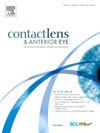MCL-PRO-CAT 的开发和初步验证:计算机化自适应测试,旨在从患者的角度测量多焦点隐形眼镜的性能。
IF 4.1
3区 医学
Q1 OPHTHALMOLOGY
引用次数: 0
摘要
目的:建立一种有效可靠的计算机自适应测试(CAT)工具,用于评估老视眼患者的多焦隐形眼镜(MCL)性能,确保其高精度。这个自我管理的工具最初将以西班牙语在线提供。方法:按照题库开发、题库改进阶段、题库改进后的题项反应理论校准、CAT模拟与设计、初步验证研究五个步骤进行正确的开发。总共有1163名老花眼患者参与了整个研究。通过将结果与CLDQ-8问卷进行比较来评估收敛效度,并在初次完成后两周进行可重复性评估。结果:最终的题库由108个项目组成,评估了MCL绩效评估的各个相关领域。校准研究表明,人分离指数为4.69,信度为0.96,测量精度为0.27。最终的CAT通过平均每位患者10.61±1.00个项目,平均完成时间为3:04±1:24分钟来区分16个水平的MCL表现。收敛效度的迹象显示相关系数为0.73,可重复性评估显示类内相关系数为0.881,95%置信区间为0.815 - 0.924,一致限为±1.07。结论:MCL- pro - cat是评估老花眼患者MCL表现的开创性工具。自动评分,项目少,可行、有效、准确,增强了临床实用性。本文章由计算机程序翻译,如有差异,请以英文原文为准。
Development and Initial Validation of the MCL-PRO-CAT: A computerized adaptive test designed to measure multifocal contact lens performance from the patient’s perspective
Purpose:
To create a valid and reliable computer-adaptive testing (CAT) tool for assessing Multifocal Contact Lens (MCL) performance in presbyopic individuals, ensuring high precision. The self-administered tool will initially be accessible online in Spanish.
Methods:
Five steps were followed for the correct development of the instruments: item bank development, item refinement phase, item response theory calibration of the refined item bank, CAT simulations and design, and an initial validation study. A total of 1163 presbyopic patients were involved in the over-all study. Convergent validity was assessed by comparing results to the CLDQ-8 questionnaire, and repeatability assessment was performed two weeks after the initial completion.
Results:
The final item bank consisted of 108 items assessing various relevant domains for MCL performance evaluation. The calibration study showed a person separation index of 4.69 and a reliability of 0.96 along with a measurement precision of 0.27. The final CAT distinguished between 16 levels of MCL performance by presenting an average of 10.61 ± 1.00 items per patient, with an average completion time of 3:04 ± 1:24 min. Signs of convergent validity showed a correlation of 0.73 and repeatability was assessed showing an intraclass Correlation Coefficient of 0.881 with a 95% Confidence Interval 0,815–0,924, and Limits of Agreement of ± 1.07.
Conclusion:
The MCL-PRO-CAT is a groundbreaking tool for evaluating MCL performance in presbyopic individuals. With automated scoring and fewer items, it was feasible, valid, and precise, enhancing clinical practicality.
求助全文
通过发布文献求助,成功后即可免费获取论文全文。
去求助
来源期刊

Contact Lens & Anterior Eye
OPHTHALMOLOGY-
CiteScore
7.60
自引率
18.80%
发文量
198
审稿时长
55 days
期刊介绍:
Contact Lens & Anterior Eye is a research-based journal covering all aspects of contact lens theory and practice, including original articles on invention and innovations, as well as the regular features of: Case Reports; Literary Reviews; Editorials; Instrumentation and Techniques and Dates of Professional Meetings.
 求助内容:
求助内容: 应助结果提醒方式:
应助结果提醒方式:


